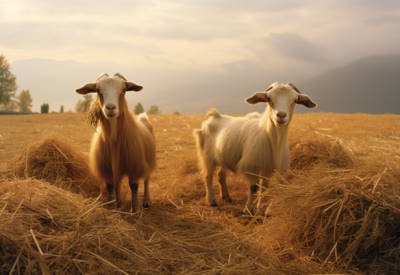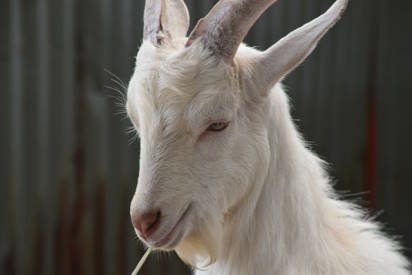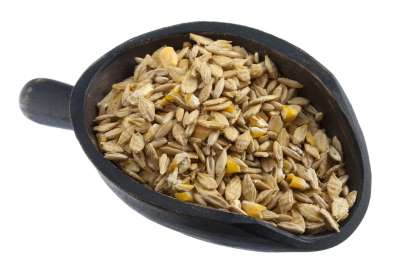When I first ventured into the delightful world of goat-keeping, the keyword on my lips was simple: diet. Can goats eat straw? It’s a question that seems to hover in the minds of many first-time goat owners, and yes, they can. However, it’s a bit more nuanced than a simple yes or no.
Growing up, I’d watch those playful creatures hopping around in pastures, nibbling on almost everything in sight. The sight always triggered a stream of questions. What are they eating? How do they choose? Are they getting the right nutrients? Like any caring animal enthusiast, ensuring the best for my furry friends became a priority.
Navigating the maze of goat dietary needs is akin to unraveling a captivating novel, with each chapter offering new insights. And while straw is but one component, it’s an essential chapter in our goats’ nutritional narrative. So, let’s dive into the pages together and understand the story of goats and straw.
Understanding Goat Diet Basics
Have you ever watched a goat munching away and wondered about the ins and outs of their dietary choices? Goats, like humans, have their own dietary needs and preferences. Let’s dive deeper.
Natural Foraging Behavior
Out in the wild, our bearded friends are true browsers. Unlike some other farm animals that graze on grasses, goats love a mix. From shrubs and trees to weeds and other coarse greenery, they’re pretty eclectic in their choices. They have this incredible knack for nosing out which plants are nutritious and which ones they should steer clear of.
Primary Diet Components
While they have varied palates, goats do have some staple foods. Think leaves, grass, herbs, and certain fruits. Of course, based on where they are and the season, they might opt for one tasty treat over another. They’re quite the discerning eaters when they want to be!
[GoatAffiliate]
What is Straw?
Ah, straw – the golden stacks often spotted on farmlands, evoking rustic vibes. But when it comes to the dietary conversation for goats, what role does straw play? Before diving into its suitability for goats, it’s essential to grasp the basics of what straw is and how it differs from other plant materials. Let’s unravel the mystery behind straw.
Straw vs. Hay: Clearing the Mix-up
People often use “straw” and “hay” interchangeably, but agriculturally speaking, they’re distinct entities. Hay is the total package: it contains the entire plant – leaves, stems, and seeds – and is harvested while the plant still has its green vitality, retaining most of its nutritional value.
On the other hand, straw is like the leftovers. Once grain crops like wheat or barley are harvested and the valuable grains removed, what remains are the dried stems, or straw.
Nutritional Profile of Straw: Beyond the Golden Hue
Appearance can sometimes be deceiving. Though straw has a beautiful golden hue, it isn’t as nutritionally golden. Predominantly, straw is made up of the fibrous parts of the plant, meaning it’s rich in cellulose. This translates to it being a good source of roughage, but it’s comparatively low in proteins, vitamins, and other nutrients essential for a well-rounded diet.
Straw’s Place in Agriculture: More Than Just Fodder
Straw has multiple roles in agriculture beyond being a potential food source. Farmers value straw for soil protection, as mulch, and even as an eco-friendly construction material. Additionally, it’s commonly used as bedding for animals, providing a comfortable resting spot in barns and stables.
Can Goats Digest Straw?
Seeing goats munch on just about anything might make you think they’ve got iron stomachs. But can they really digest something like straw?
Goat Digestive System
Goats belong to the cool club of ruminants. These animals have a four-compartment stomach, each designed to help them break down tough and fibrous plant materials. It’s a well-oiled machine that lets them extract nutrients from a variety of sources.
Straw in a Goat’s Diet
Given their advanced digestive setup, goats can indeed process straw. It’s not a gourmet meal by any stretch, but it can act as a filler in their diet.
Pros and Cons of Feeding Straw to Goats
Are you navigating the dietary decisions for your goats? Straw might be on your radar. Like all feed options, straw has its advantages and drawbacks. Let’s weigh the scales and delve into the good, the bad, and the scratchy when it comes to feeding straw to your goats.
Benefits of Straw in a Goat’s Diet
- Roughage Boost: Just as we need fiber to ensure our digestive tracts run smoothly, goats benefit from roughage, and straw can provide that. It helps in digestion and promotes a healthy gut, making sure everything flows as it should.
- Affordable Bedding and Snack Combo: Let’s get economical for a second. Straw is a common choice for bedding because it’s affordable. So if you’re using it for bedding and your goats fancy a nibble here and there, it’s like a two-for-one deal.
- Low-Calorie Filler: For goats that might be a tad overweight or ones you’re trying to put on a diet without letting them feel starved, straw can act as a filler. It can keep them munching without adding significant calories.
Limitations and Concerns
- Lacks Nutritional Value: If a goat’s diet is heavy on straw, they might be missing out on essential nutrients. Straw’s like the plain crackers of the goat world—okay in small amounts, but not super nutritious on its own.
- Quality Control Issues: Poorly stored or low-quality straw can lead to problems like mold, which can be harmful if ingested. Always ensure your straw is stored correctly and free from contaminants.
- Overconsumption Risks: While goats have robust digestive systems, excessive straw without a balanced diet can lead to potential digestive issues. Moderation is the name of the game.
By understanding the pros and cons of straw in a goat’s diet, you can make informed choices that prioritize the health and happiness of your hoofed pals.
Tips for Introducing Straw to a Goat’s Diet
Are you thinking of jazzing up your goat’s meal plan with some straw? Here’s the lowdown on doing it right.
Start Slow
It’s like introducing a new food to a toddler – you want to take it slow. Begin with small amounts of straw and keep an eye out for any changes in behavior or digestion.
Mixing with Other Feeds
To strike a balance, mix straw with other nutrient-rich feeds. This ensures your goat gets the good stuff while also benefiting from the straw’s roughage.
Monitoring Health and Behavior
The key is to be observant. If your goat’s acting off or showing signs of discomfort, it might be time to reevaluate.
Storage and Quality Control
Straw might seem like a straightforward agricultural product, but when it’s being considered for consumption or bedding, the way it’s stored and the quality checks in place become paramount.
Just as we wouldn’t want to consume stale chips from the back of our pantry, our goats deserve the freshest and safest of straws. Let’s delve into the art and science of ensuring our straw is top-notch.
Storing Straw: The Do’s and Don’ts
- Keep it Dry: Moisture is the nemesis of stored straw. Wet or damp straw can become a breeding ground for mold and mildew, both of which are detrimental to goats when ingested. So, always ensure that your storage area is dry, with good airflow.
- Avoid Direct Sunlight: While a sun-soaked barn might seem idyllic, direct sunlight can degrade the quality of straw over time. It’s best to store straw in a shaded spot or under a tarp to prevent it from becoming too brittle or losing its structure.
- Elevate from Ground: Laying pallets or using raised platforms can be beneficial. It ensures that the straw doesn’t directly touch the ground, minimizing the risk of it drawing moisture or becoming a home for pests.
Quality Checks: Ensuring Only the Best for Our Goats
- Inspect for Contaminants: Before letting your goats near the straw, do a thorough inspection. Be on the lookout for foreign objects, chemicals, or pesticides. Remember, some straw might be treated or processed differently, so always verify its safety for animal consumption.
- Check for Freshness: Like most agricultural products, straw isn’t timeless. Over time, it can degrade and lose its quality. Fresh straw has a vibrant golden hue and a certain crispness to it. If it looks faded, feels overly brittle, or has an off smell, it’s probably past its prime.
- Source Responsibly: It always pays to know where your straw comes from. Try to buy from reputable sellers or farmers who can provide insights into how the straw was grown, harvested, and processed.
By being meticulous in our storage practices and vigilant in our quality checks, we ensure that the straw we provide our goats is not just good but the best. After all, they deserve nothing less!
What Other Animal Fodder Can Goats Eat Apart From Straw?
Beyond the world of straw, the menu for goats is diverse and delightful. Goats, known for their curious appetites, have a variety of options that provide them with the right nutrients and keep them in tip-top shape. So, what are these other delicacies that goats can nibble on? Let’s dive into some popular fodder options and find out.
Timothy Hay
Timothy hay is a favorite among many herbivores, and goats are no exception. Rich in fiber and packed with essential nutrients, timothy hay makes an excellent feed for goats, helping promote digestion and overall health. It’s a well-rounded choice that offers a good balance of protein and fiber, making it a staple for many goat keepers.
Read More: Can Goats Eat Timothy Hay? Unveiling The Full Story
Alfalfa
Hello, protein-packed goodness! Alfalfa is like the protein shake of the goat world. With a high protein, vitamin, and mineral content, alfalfa is fantastic for lactating does and growing kids. However, due to its richness, it should be given in moderation to other goats to prevent them from becoming overweight.
Read More: Can Goats Eat Alfalfa? Ultimate Healthy Feeding Guide
Sweet Feed
Sweet feed is like the candy of the fodder world. Composed of grains, molasses, and other nutrients, sweet feed is tasty and is often gobbled up by goats with enthusiasm. However, just like candies for us, it should be given as a treat and not a primary diet. Too much sweet feed can lead to obesity and other health issues in goats.
Read More: Can Goats Eat Sweet Feed? 5 Excellent Benefits
Beet Pulp
Beet pulp, a byproduct of sugar beet processing, is a fantastic source of digestible fiber for goats. It acts as an energy booster and is particularly beneficial during colder months when goats need extra calories to stay warm. When soaked, it becomes a mushy treat that many goats adore.
Read More: Can Goats Eat Beet Pulp? 7 Excellent Benefits
Bermuda Hay
Bermuda hay is another excellent hay choice for goats. With a fine texture and good nutrient balance, it provides essential roughage to a goat’s diet, promoting digestion and well-being. Though not as protein-rich as alfalfa, it’s a safe and steady option for daily feeding.
Read More: Can Goats Eat Bermuda Hay? A Delicious Dive into Dietary Choices
Frequently Asked Questions (FAQs) about Goats and Straw
Do all goat breeds react to straw the same way?
While the basic digestive system of goats is similar across breeds, there might be slight variations in preferences and tolerances. Always observe your particular breed and individual goat’s reaction to different fodder, including straw.
Can baby goats (kids) eat straw?
Kids are often curious and might nibble on straw. However, their primary diet should be milk or milk replacer initially, slowly introducing hay and grains as they grow. While a bit of straw won’t harm them, it shouldn’t be their main feed.
How can I introduce straw to my goat’s diet?
If you’re introducing straw, do it gradually. Start by mixing it with their regular feed and observe for any changes in their digestion or behavior.
Can straw replace water in a goat’s diet?
No, straw cannot replace water. Goats, like all animals, need a constant supply of fresh water to stay hydrated and healthy.
What should I do if my goat overeats straw?
If you notice your goat has consumed a significant amount of straw, monitor it for any signs of digestive discomfort. While a one-time overconsumption might not be immediately harmful, making it a habit can lead to nutritional deficiencies.
Can goats eat straw – final thoughts
As we’ve journeyed through the straw-laden paths of goat diets, it’s become clear that while our bearded buddies can indeed munch on straw, it’s more of a snack or comfy bed than a main course. Think of it as goats enjoying a light popcorn treat during their movie night – fun and crunchy but not exactly dinner material.
So, can goats eat straw? Absolutely! But as with all things in life, moderation is key. Armed with this knowledge, you can now confidently craft a diverse and nutritious menu for your four-legged friend.
Related Articles:







